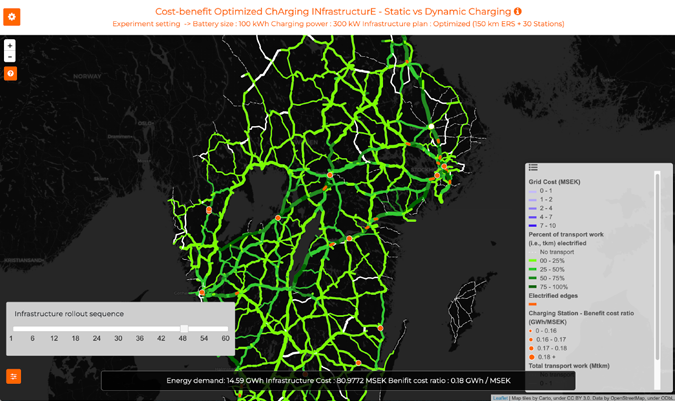To reach climate goals, a well-planned charging infrastructure is paramount for a rapid, efficient, and smooth transport electrification transition. To this end, in the SEC-funded project LOLA, researchers are building a model and method to plan cost-effective charging infrastructures.

A well-planned charging infrastructure that can meet the charging demand of commercial, electric heavy-freight vehicles is necessary to accelerate transport electrification. But the required infrastructure investments are high and risky, so stakeholders need accurate decision support to estimate the return on investments, ROI, for different charging infrastructure plans. But the number of possible plans is endless. One can install electric roads, charging stations, or a mix of these. One can place these different types of charging infrastructure components forming a network in virtually an infinite amount of possible ways on the road network. Also, one can dimension the charging capacity of each of these components.
The LOLA project looks into how to incorporate charging stations as an electrification option and how to effectively model the charging infrastructure costs, including the cost of grid connections that is required to supply the charging demand, in the cost-benefit optimization of charging infrastructure plans.
An interactive map allows the user the explore the ROI of an optimized charging infrastructure roll-out plan. Add target transport routes to be electrified, some predefined scenario setups, such as vehicle battery sizes, maximum charging power per vehicle, charging time limits at stations, and electrification budget in terms of a lane-kms of electric roads and number of charging stations, and the map suggests the most efficient plan.
Vehicles with batteries already fully charged have limited use of an electric road segment and thus locations should be electrified from the premise of the vehicles’ need for charging and not from where there is a lot of vehicle traffic. Prior research has shown that the charging needs of vehicles and the charging utility of locations are primarily influenced by the vehicle’s routes, not the traffic counts.
“Electric road network plans that are optimized based on the vehicle routes can electrify up to three times the transport work and hence can yield up to three times as many revenues compared to traffic count-based corridor plans”, says LOLA’s project leader, Gyözö Gidofalvi, Associate Professor in Geoinformatics, ITRL, KTH.
Stationary charging at stations takes a relatively long time hence will be most attractive at locations where the driver can use the time during charging for other activities. These locations will most likely be at the start and end of the route and around five hours into the route when loading, unloading and mandatory rest stops usually take place. Thus, as with electric roads, the charging needs and the charging utilities along the route should primarily depend on routes and not the traffic counts.
To maximize ROI, the model also estimates the grid cost and the charging equipment cost that is required to satisfy the estimated charging need for both electric roads and charging stations. The model then develops an optimized roll-out plan, combining these conclusions.
“Preliminary results show that the optimized charging stations may have a larger ROI than the optimized electric roads. However, for the large-scale electrification scenarios, the charging demand on charging stations is well into the double-digit MW ranges, something that requires large charging infrastructure and grid reinforcement investments, says Gyözö Gidofalvi.
To ensure that the right type of infrastructure development happens at the optimal locations and thereby avoid huge losses in investments in long-term infrastructure, Distribution Service Operators (DSOs) and Charging Point Operators (CPOs) need accurate evidence-based decision support. The maps and statistics produced in the LOLA project are just a start and some indications. The DSOs and CPOs will need to do a sensitivity analysis of the scenarios, grid enforcement optimizations, and cost estimations in the grid.
“Also, charging stations appear to be a better infrastructure investment option than electric roads now, but the opposite might be true in an autonomous transport future when stopped vehicles are considered “waste” from an operational efficiency perspective,” says Gyözö Gidofalvi.